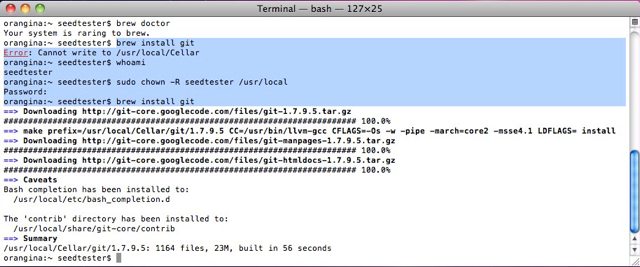

- #Brew install postgresql 9.3 full#
- #Brew install postgresql 9.3 software#
- #Brew install postgresql 9.3 password#
- #Brew install postgresql 9.3 mac#
Note that building the 9.3/9.4 version of pg_rewind requires the PostgreSQL source code.
#Brew install postgresql 9.3 full#
If the pg_rewind binary is not installed in the PostgreSQL bin directory, provide its full path on the demotion candidate with -force-rewind. If PostgreSQL is no longer installed on your computer, open My Computer and browse to your Program Files/PostgreSQL directory. If PostgreSQL is still installed on your computer, go Start -> Programs and look for PostgreSQL (version) to determine the release version of PostgreSQL installed on your computer. If that's not set to /usr/share/pgsql/extension then likely your postgresql-contrib was packaged by someone different than your copy of postgresql. You need to check what SHAREDIR is set to with pg_config -sharedir. PostgreSQL will create the extension using details from the file SHAREDIR/extension/extension_ntrol. In principle, this makes it pretty easy to switch between two installed versions. Only symbolic links to this folder are then installed globally. What probably happened is that the extension was originally added to the cluster at some point in the past and then you probably created a new database within that cluster afterward.ġ) Check, whether the version is already installed (but not activated) When homebrew installs a new formula, it puts it in a versioned directory like /usr/local/Cellar/postgresql/9.3.1. Docker is not an alternative in this case.
#Brew install postgresql 9.3 software#
Initially, the server has only the most basic software (and PostgreSQL is not included there). So, one of the rules, is that we can have only one user there and everything should be installed under this user (with sudo rights). If it exists, please include it in any problem reports. You can find it in the "pg_log" folder inside the data directory you chose for PostgreSQL. This may not exist if installation failed early on, but it can be very informative for errors that happened later in installation. The PostgreSQL server has its own error log.
#Brew install postgresql 9.3 password#
By the way, if you have forgotten your Postgres account password while installing the first time, just open a Command Prompt in Vista (If you don’t know how, Google for it). What this means for you is that you need to install PostgreSQL in another folder that is not inside Program Files. error: formula `postgresql` is not installed. Then it runs launchctl load ~/Library/LaunchAgents/. See you in the next tutorial.$ brew services start mysql => Successfully started ` mysql ` (label: ) Behind the scenes, brew services start is doing everything in the post-install message above. Please share this tutorial if it was helpful. postgres=# \qĪlright, this brings us to the end of this tutorial. To exit or quit from psql type the \q command. Public | users_id_seq | sequence | yusufshakeel Now if we list the tables using the \d command we will get the table. In the following example we are creating a simple users table. Let us go ahead and create a simple users table inside the mydb database and try the above command again.

Note! If there is no table then we will get a prompt stating no relations found. To list all the tables inside a database we run the \d command. You are now connected to database "mydb" as user "yusufshakeel". To connect to a database use the \c command. In the given example mydb is the name of the database. To create a database run the following command. Template1 | yusufshakeel | UTF8 | C | C | =c/yusufshakeel + Template0 | yusufshakeel | UTF8 | C | C | =c/yusufshakeel + Name | Owner | Encoding | Collate | Ctype | Access privileges To list all the databases run the \l command. Yusufshakeel | Superuser, Create role, Create DB, Replication, Bypass RLS | To list all the users we use the \du command. So, to connect to it we will run the following command. => Successfully started `postgresql` (label: )īy default we will get a database by the name postgres. We will get a similar output as shown below. To restart PostgreSQL run the following command in the Terminal. => Successfully stopped `postgresql` (label: ) To stop PostgreSQL run the following command in the Terminal. => Successfully started `postgresql` (label: ) We will get a similar output shown below. To start PostgreSQL run the following command in the Terminal. We can check the version of PostgreSQL using the psql command.
#Brew install postgresql 9.3 mac#
In Terminal run the following command to install PostgreSQL on Mac using Homebrew. $ brew updateĪlright, time to install PostgreSQL on Mac. brew) installed on your machine you can run the following command in the Terminal to check the version. You can visit Homebrew official website to learn more about it. If you don't have Homebrew installed on your Mac then open Terminal and run the following command. It is assumed that you have Homebrew installed on your Mac. In this tutorial we will learn to install PostgreSQL database on Mac using Homebrew.


 0 kommentar(er)
0 kommentar(er)
